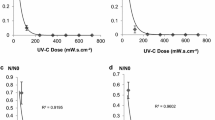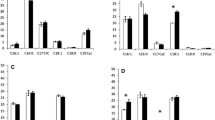Abstract
The present study was carried out to evaluate the effects of ultraviolet radiations (UV-C) on the fatty acids composition of three serovars of Salmonella: S. typhimurium, S. hadar and S. zanzibar. Results obtained show that UV-C treatment increases significantly (P ≤ 0.05) the percentage of cyclic fatty acids. The atomic force microscopy was used to study the morphology and cell surface of irradiated strains. Results show that UV-C rays induce morphological changes and alter the bacterial cell surface (presence of grooves and irregularities).




Similar content being viewed by others
Change history
12 February 2022
A Correction to this paper has been published: https://doi.org/10.1007/s11274-021-03219-8
References
Alvarez-Ordonez A, Fernandez A, Lopez M, Arenas R, Bernardo A (2008) Modifications in membrane fatty acid composition of Salmonella typhimurium in response to growth conditions and their effect on heat resistance. Int J Food Microbiol 123:212–219
Andrews-Polymenis HL, Santiviago CA, McClelland M (2009) Novel genetic tools for studying foodborne Salmonella. Curr Opin Biotechnol 2:149–157
Ben Abdallah F, Lagha R, Bakhrouf A (2008) Resucitation and morphological alterations of Salmonella bovismorbificans cells under starvation in soil. World J Microbiol Biotechnol 24:1507–1512
Bintsis T, Litopoulou-Tzanetaki E, Robinson R (2000) Existing and potential applications of ultraviolet light in the food industry. A critical review. J Sci Food Agric 80:637–645
Blatchley ER (1996) Ultraviolet irradiation and chlorination/dechlorination for municipal wastewater disinfection. Water Environ Res 68:194–198
Braga PC, Ricci D (1998) Atomic force microscopy: application to investigation of Escherchia coli morphology before and after exposure to cefodizime. Antimicrob Agents Chemother 42:18–22
Brown JL, McMeekin TA, Nicholas PD (1997) Acid habituation of Escherichia coli and the potential role of cyclopropane fatty acids in low pH tolerance. Int J Food Microbiol 37:163–173
Buchanan RL, Edelson SG, Marmer BS (1999) Influence of acidulant identity on the effects of pH and acid resistance on the radiation resistance of Escherichia coli O157:H7. Food Microbiol 21:51–57
Chang YY, Cronan JE (1999) Membrane cyclopropane fatty acid content is a major factor in acid resistance of Escherichia coli. Mol Microbiol 33:249–259
Duforc EJ, Smith IC, Jarrell HC (1984) Role of cyclopropane moieties in the lipid properties of biological membranes: a 2H NMR structural and dynamical approach. Biochemistry 23:2300–2309
Eaton P, Fernandes JC, Pereira E, Pintado ME, Malcata FX (2008) Atomic force microscopy study of the antibacterial effects of chitosans on Escherichia coli and Staphylococcus aureus. Ultramicroscopy 108:1128–1134
Foster JW, Spector MP (1995) How Salmonella survive against the odds. Annu Rev Microbiol 49:145–174
Greenacre EJ, Brocklehurst TF, Waspe CR, Wilson DR, Wilson PDG (2003) Salmonella enterica serovar Typhimurium and Listeria monocytogenes acid tolerance response induced by organic acid at 20 °C: optimization and modeling. Appl Environ Microbiol 69:3945–3951
Hassen A, Mahrouk M, Ouzari H, Cherif M, Boudabous A, Damelincourt J (2000) UV disinfection of treated wastewater in a large-scale pilot plant and inactivation of selected bacteria in a laboratory UV device. Bioresource Technol 74:141–150
Hazel JR, Williams EE (1990) The role of alterations in membrane lipid composition in enabling physiological adaptation of organisms to their physical environment. Prog Lipid Res 29:167–227
Heipieper HJ, Diefenbach R, Keweloh H (1992) Conversion of cis unsaturated fatty acids to trans, a possible mechanism for the protection of phenol-degrading Pseudomonas putida P8 from substrate toxicity. Appl Environ Microbiol 58:1847–1852
Jiang X, Chai TJ (1996) Survival of Vibrio parahaemolyticus at low temperatures under starvation conditions and subsequent resuscitation of viable non culturable cells. Appl Environ Microbiol 62:1300–1305
Kaneda T (1977) Fatty acids of genus Bacillus: an example of branched chain preference. Bacteriol Rev 41:391–418
Kjelleberg S, Flardh K, Nystrom T, Moriarty DJW (1993) Growth limitation and starvation of bacteria. In: Ford TE (ed) Aquatic microbiology: an ecological approach. Blackwell Scientific Publications. Inc, Boston, pp 289–320
Kloula S, Chatti A, Sethom MM, Maalej L, Mihoub M, Kefacha S, Feki M, Landoulsi A, Hassen A (2013) Changes in membrane fatty acid composition of Pseudomonas aeruginosa in response to UV-C radiations. Curr Microbiol 67:112–117
Loffeld B, Keweloh H (1996) Cis/trans isomerization of unsaturated fatty acids as possible control mechanism of membrane fluidity in Pseudomonas putida P8. Lipids 31:811–815
Mazzota AS (2001) Thermal inactivation of stationary-phase and acid adapted E. coli O157:H7, Salmonella and Listeria monocytogenes in fruit juices. J Food Protect 64:315–320
Russell NJ (1984) Mechanisms of thermal adaptation in bacteria: blueprints for survival. Trends Biochem Sci 9:108–112
Sasser M, Kunitsky C, Jackoway G et al (2005) Identification of Bacillus anthracis from culture using gas chromatographic analysis of fatty acid methylesters. J AOAC Int 88:178–181
Smith HL, Howland MC, Szmodis AW, Li Q, Daemen LL, Parikh AN, Majewski J (2009) Early stages of oxidative stress-induced membrane permeabilization: a neutron reflectometry study. J Am Chem Soc 131:3631–3638
Wilde S, Jorgensen F, Campbell A, Rowbury R, Humphrey T (2000) Growth of Salmonella enterica serovar Enteritidis PT4 in media containing glucose results in enhanced RopS-independent heat and acid tolerance but does not affect the ability to survive air-drying on surfaces. Food Microbiol 17:679–686
Wouters JA, Jeynov B, Rombouts FM, DeVos MW, Kwipers OP, Abee T (1999) Analysis of the role of 7 kDa cold shock proteins of Lactobacillus lactis MG1363 in cryoprotection. Microbiology 145:3185–3194
Wouters JA, Frenkiel H, De Vos MW, Kwipers OP, Abee T (2001) Cold shock proteins of Lactobacillus lactis MG1363 are involved in cryoprotection and in the production of cold-induced proteins. Appl Environ Microbiol 67:5171–5181
Yativan MB, Klessig DR, Dennis WH (1986) Hyperthermic sensitivity and growth stage in Escherichia coli. Rad Res 106:78–88
Yeo SK, Liong MT (2013) Effects and applications of sub-lethal ultrasound, electroporation and UV radiations in bioprocessing. Ann Microbiol 63:813–824
Author information
Authors and Affiliations
Corresponding author
Additional information
Lobna Maâlej and Abdelwaheb Chatti have contributed equally in this work.
Rights and permissions
About this article
Cite this article
Maâlej, L., Chatti, A., Khefacha, S. et al. UV-C pre-adaptation of Salmonella: effect on cell morphology and membrane fatty acids composition. World J Microbiol Biotechnol 30, 925–930 (2014). https://doi.org/10.1007/s11274-013-1510-2
Received:
Accepted:
Published:
Issue Date:
DOI: https://doi.org/10.1007/s11274-013-1510-2




